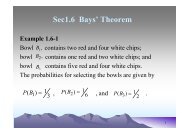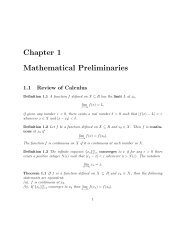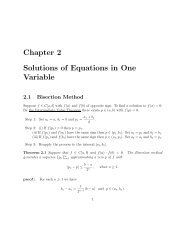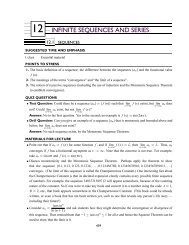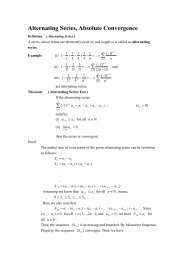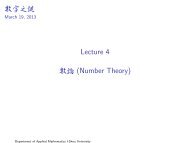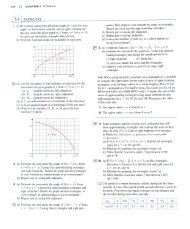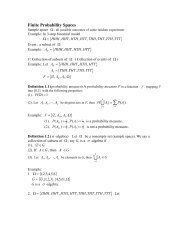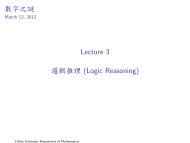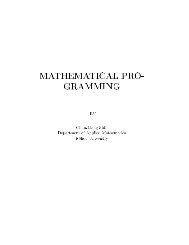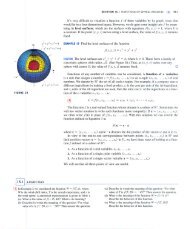2 LIMITS
2 LIMITS
2 LIMITS
You also want an ePaper? Increase the reach of your titles
YUMPU automatically turns print PDFs into web optimized ePapers that Google loves.
2 <strong>LIMITS</strong>2.1 THE TANGENT AND VELOCITY PROBLEMSTRANSPARENCY AVAILABLE#2 (Figure 3)SUGGESTED TIME AND EMPHASIS12– 1 class Essential materialPOINTS TO STRESS1. The tangent line viewed as the limit of secant lines.2. The concepts of average versus instantaneous velocity, described numerically, graphically, and in physicalterms.3. The tangent line as the line obtained by “zooming in” on a smooth function; local linearity.4. Approximating the slope of the tangent line using slopes of secant lines.QUIZ QUESTIONS• Text Question: Geometrically, what is “the line tangent to a curve” at a particular point?Answer: There are different correct ones. Examples include the best linear approximation to a curve at apoint, or the result of repeated “zooming in” on a curve.• Drill Question: Draw the line tangent to the following curve at each of the indicated points:yy=f(x)xAnswer:yy=f(x)x35
CHAPTER 2<strong>LIMITS</strong>MATERIALS FOR LECTURE• Point out that if a car is driving along a curve, the headlights will point along the direction of the tangentline.• Discuss the phrase “instantaneous velocity.” Ask the class for a definition, such as, “It is the limit ofaverage velocities.” Use this discussion to shape a more precise definition of a limit.• Illustrate that many functions such as x 2 and x − 2sinx look locally linear, and discuss the relationshipof this property to the concept of the tangent line. Then pose the question, “What does a secant line to alinear function look like?”• Show that the slope of the tangent line does not exist at x = 0 for either of f (x) = 3√ x and g (x) = |x|.Note that f has a tangent line (which is vertical), but g does not (it has a cusp). The absolute value functioncan be explored graphically using TEC Module 2.1.WORKSHOP/DISCUSSION• Estimate slopes from discrete data, as in Exercises 2 and 8.• Estimate the slope of y = 3) (1,1 + x 2 at the point 3 2using the graph (perhaps with a graphing calculator),and then numerically. Draw the tangent line to this curve at the indicated point. Do the same for the points( )(0, 3) and 2, 3 5.( ) 1• Explore the curve y = sin at x =x 12π and x = 1 . Notice the difference in the quality of theπ/2tangent line approximations.GROUP WORK 1: What’s the Pattern?The students will not be able to do Part 3 from the graph alone, although some will try. After a majority ofthem are working on Part 3, announce that they can do this numerically.If they are unable to get Part 6, have them repeat Part 4 for x = 15, and again for x = 0.Answers:1., 2.y323. 2 − √ 3 ≈ 0.268, √ 5 − 2 ≈ 0.236,√ √√ √ 4.2 − 3.84.5 − 3.5 ≈ 0.250,0.4is a good estimate.4. 1 4≈ 0.250_110 1 2 3 4 5 6 7 8 x5. 1 6is a good estimate.16.2 √ a + 136
SECTION 2.1THE TANGENT AND VELOCITY PROBLEMSGROUP WORK 2: Slope PatternsWhen introducing this activity, it may be best to fill out the first line of the table with your students, or toestimate the slope at x =−1. If a group finishes early, have them try to justify the observations made in thelast part of Problem 2.Answers:1. (a) 0, 0.2, 0.4, 0.6 (b) 11.52. (a) Estimating from the graph gives that the function is increasing for x < −3.2, decreasing for−3.2 < x < 3.2, and increasing for x > 3.2.(b) The slope of the tangent line is positive when the function is increasing, and the slope of the tangentline is negative when the function is decreasing.(c) The slope of the tangent line is zero somewhere between x =−3.2and−3.1, and somewhere betweenx = 3.1and3.2. The graph has a local maximum at the first point and a local minimum at the second.(d) The tangent line approximates the curve worst at the maximum and the minimum. It approximatesbest at x = 0, where the curve is “straightest,” that is, at the point of inflection.TEC GROUP WORK 3: How Fast do You Slope In?In this exercise students use TEC Module 2.1 to explore how quickly the slopes of secant lines approach theslope of the tangent line.Answers:1. (a) −1, − 1 2 , − 1 3(b) 1.43 < b < 2 (c)2 < b < 3.33 (d) The interval is larger to the right of 2.2. 1.24 < b < 1.54, 1.58 < b < 30. The latter is a much larger interval.3. 3.08 < b < 3.19, −1.95 < b < −1.18 4. a = 4, the ranges are the same, a = 0HOMEWORK PROBLEMSCore Exercises: 1, 2, 4, 5, 7Sample Assignment: 1, 2, 4, 5, 7, 9Exercise D A N G1 × × × ×2 × × × ×4 × ×5 ×7 × × ×9 × ×37
What’s the Pattern?4. Using the slopes you’ve found so far, estimate the slope of the tangent line at x = 3.5. Repeat Problem 4 for x = 8.6. Based on Problems 4 and 5, guess the slope of the tangent line at any point x = a,fora > −1.39
2.2 THE LIMIT OF A FUNCTIONSUGGESTED TIME AND EMPHASIS1 class Essential materialPOINTS TO STRESS1. The various meanings of “limit” (descriptive, numeric, graphic), both finite and infinite. Note thatalgebraic manipulations are not yet emphasized.2. The geometric and limit definitions of vertical asymptotes.3. The advantages and disadvantages of using a graphing device to compute a limit.QUIZ QUESTIONS• Text Question: What is the difference between the statements “ f (a) = L” and “ lim f (x) = L”?x→aAnswer: Thefirstisastatementaboutthevalueof f at the point x = a, the second is a statement aboutthe values of f at points near, but not equal to, x = a.• Drill Question: The graph of a function f is shown below. Are the following statements about f true orfalse? Why?(a) x = a is in the domain of f (b) lim f (x) exists (c) lim f (x) is equal to lim f (x)x→a x→a + x→a −y0 axAnswer:(a) True, because f is defined at x = a.(b) True, because as x gets close to a, f (x) approaches a value.(c) True, because the same value is approached from both directions.MATERIALS FOR LECTURE• Present the “motivational definition of limit”: We say that lim f (x) = L if as x gets close to a, f (x) getsx→aclose to L, and then lead into the definition in the text. (Note that limits will be defined more precisely inSection 2.4.)• Describe asymptotes verbally, and then give graphic and limit definitions. If foreshadowing horizontalasymptotes, note that a function can cross a horizontal asymptote. Perhaps foreshadow the notion of slantasymptotes, which are covered later in the text.• Discuss how we can rephrase the last section’s concept as “the slope of the tangent line is the limit of theslopes of the secant lines as x → 0”.42
SECTION 2.2THE LIMIT OF A FUNCTION• Stress that if lim f (x) = ∞ and lim g (x) = ∞, then we still don’t know anything aboutx→a x→a[ ] f (x) − g (x) .limx→aWORKSHOP/DISCUSSION• Explore the greatest integer function f (x) = [[x]] on the interval [−1, 2] in terms of left-hand and righthandlimits.(• Explore lim 2 − 21/x ) , looking carefully at 2 1/x from both sides for small x.x→0numerical, and algebraic (“what happens to 1/x when x is small?”) contexts.Discuss in graphical,x − 3• Discuss a limit such as lim . When can you “just plug in the numbers”?x→3 4x + 2GROUP WORK 1: Infinite LimitsAfter the students are finished, Problem 2 can be used to initiate a discussion of left and right hand limits,and of the precise definition of a vertical asymptote, as presented in the text. In addition, Section 4.4 canbe foreshadowed by asking the students to explore the behavior of 3x2 + 4x + 5√ for large positive and large16x 4 − 81negative values of x, both on the graph and numerically. If there is time, the students can be asked to analyzethe asymptotes of f (x) = sec x and the other trigonometric functions.Answers:1. Answers will vary. The main thing to check is that there are vertical asymptotes at ± π 2 and at ± 3π 2 .2.y20There are vertical asymptotes at x =±1.5.10_4 _2 0 2 4x43
CHAPTER 2<strong>LIMITS</strong>GROUP WORK 2: The Shape of Things to ComeThis exercise foreshadows concepts that will be discussed later, but can be introduced now. The idea is toshow the students that the concept of “limit” can get fairly subtle, and that care is needed. The second pageforeshadows Section 4.4, and the third page foreshadows Section 2.4. Pages 2 and 3 are independent of eachother; either or both can be used. Problem 3 on page 3 is a little tricky and can be omitted if desired.Answers:Page 11. 2 1 = 2, (0.6) 2 = 0.36, (0.8) 3 = 0.512, 0 4 = 0, (1.01) 8 = 1.08292.y2f§ f£föfªfÁ3. f n (1) = 1foralln.4. The curves all go through the origin.1_1 0 1 2 xPage 2_11. (a) 0 (b) 1 (c) 1 (d) 132(e)2. (a) 0 (b) 0 (c) 0 (d) 13. (a) 1 (b) 0The function f (x) = lim f n (x) is often seen in real analysis. It looks like this:n→∞y112560 1 xPage 311.102. Estimates will vary.√3. 10110− 1 ≈ 0.0049876. (For Problems 1 and 3, any number less than the given answer is correct.)4. Yes, the problems could have been done with any smaller positive number.44
SECTION 2.2THE LIMIT OF A FUNCTION5. The students can be forgiven for not answering this question. It will be fully answered in Section 2.4. Theshort answer: Let a be the “small number you can name.” Then we have shown that we can always find asmallintervalaboutx such that ∣ ∣x 2 − 0 ∣ < a. A similar argument can be made for the second part. Themain idea here is to set up ideas that will be explored more fully in Section 2.4.GROUP WORK 3: Why Can’t We Just Trust the Table?This activity was inspired by the article “An Introduction to Limits” from College Mathematics Journal,January 1997, page 51, and extends Example 4.Put the students into groups and give each group two different digits between 1 and 9, and then let themproceed with the problems in the handout.Answers:1. The answer, of course, depends on the starting digit:x sin π x0.1 00.01 00.001 00.0001 00.00001 00.000001 0x sin π x0.4 10.04 00.004 00.0004 00.00004 00.000004 0x sin π x0.7 −0.9749279120.07 0.7818314820.007 0.4338837390.0007 0.9749279120.00007 −0.7818314820.000007 −0.4338837392. Answers will vary.x sin π x0.2 00.02 00.002 00.0002 00.00002 00.000002 0x sin π x0.5 00.05 00.005 00.0005 00.00005 00.000005 0x0.8 −sin π x√220.08 10.008 00.0008 00.00008 00.000008 045x0.3 −0.03 −0.003 −0.0003 −0.00003 −0.000003 −x0.6 −0.060.0060.00060.000060.000006sin π x√32√32√32√32√32√32sin π x√32√32√32√32√32√32x sin π x0.9 −0.3420201430.09 −0.3420201430.009 −0.3420201430.0009 −0.3420201430.00009 −0.3420201430.000009 −0.342020143
CHAPTER 2<strong>LIMITS</strong>3. Answers will vary.4. There is no limit.y101 x_1HOMEWORK PROBLEMSCore Exercises: 3, 7, 10, 15, 17, 22, 27, 40Sample Assignment: 3, 4, 7, 8, 10, 15, 17, 20, 22, 27, 34, 36, 37, 40Exercise D A N G3 ×4 × ×7 × ×8 ×10 × ×15 ×17 ×Exercise D A N G20 ×22 × ×27 ×34 × ×36 × ×37 ×40 × ×46
GROUP WORK 1, SECTION 2.2Infinite Limits1. Draw an odd function which has the lines x = π 2 and x =−3π 2among its vertical asymptotes.2. Analyze the vertical asymptotes of 3x2 + 4x + 5√16x 4 − 81 . 47
GROUP WORK 2, SECTION 2.2The Shape of Things to ComeIn this activity we are going to explore a set of functions:f 1 (x) = xf 2 (x) = x 2f 3 (x) = x 3.f n (x) = x n , n any positive integer1. To start with, let’s practice the new notation. Compute the following:f 1 (2) = f 2 (0.6) = f 3 (0.8) = f 4 (0) = f 8 (1.01) =2. Sketch the functions f 1 , f 2 , f 3 , f 6 ,and f 8 on the set of axes below.3. The number 0 plays a special role, since f n (0) = 0 n = 0foranyn. Find another number a > 0suchthatf n (a) = a for all n.4. We know that limx→0f n (x) = 0foranyn. How is this fact reflected on your graphs above?48
GROUP WORK 2, SECTION 2.2The Shape of Things to Come: Approaching Infinity1. Using what you know about limits, compute the following quantities:(a) lim f 3 (x) (b) lim f 4 (x)x→0 x→1(c)( )lim f 15 (x) (d) lim f 12 n x→1 n→5(e) limn→8f n(12)2. Using what you know about limits, compute the following quantities:( )(a) lim f 12n(b) lim f n (0.99)n→∞ n→∞(c)limn→∞ f n (x),wherex < 1 (d) limn→∞ f n (1)3. Are the following quantities defined? If so, what are they? If not, why not?( )( )(a) lim lim f n→∞ x→1 − n (x)(b) lim lim fx→1 − n (x)n→∞49
GROUP WORK 2, SECTION 2.2The Shape of Things to Come: The Nitty-GrittyBy definition, “ lim f 2 (x) = 0” means that by taking x very close to zero, we can make ∣ ∣x 2 − 0 ∣ smaller thanx→0any small number you can name.1. Find a number δ > 0suchthatif−δ < x < δ,then| f 2 (x)| 0suchthatif−δ < x − 1 < δ,then ∣ ∣x 2 − 1 ∣ ∣ < 1100 .3. Now use algebra to find a number δ > 0suchthatif−δ < x − 1 < δ, then ∣ ∣x 2 − 1 ∣ ∣ < 1100 .14. When constructing this problem,100was used as an arbitrary smallish number. Could you have done theprevious problems if we replaced100 1 by 110,000 ? How about 11,000,000 ?5. Reread the first two sentences of this page. How do your answers to Problems 1 and 4 show thatlim f (2 (x) = 0? Do your answers to Problems 2, 3, and 4 show that lim x 2 − 1 ) = 0? Why?x→0 x→150
GROUP WORK 3, SECTION 2.2Why Can’t We Just Trust the Table?We are going to investigate lim sin π . We will take values of x closer and closer to zero, and see what valuex→0 xthe function approaches.1. Your teacher has given you a digit — let’s call it d. Fill out the following table. If, for example, yourdigit is 3, then you would compute sin ( ) (π0.3,sinπ) (0.03,sinπ) (0.003 ,sinπ0.0003),etc.2. What is limx→0sin π x ?0.d0.0dx0.00d0.000d0.0000d0.00000dsin π x3. Now fill out the table with a different digit.0.dxsin π x0.0d0.00d0.000d0.0000dDo you get the same result?0.00000d4. What is limx→0sin π x ? 51
2.3 CALCULATING <strong>LIMITS</strong> USING THE LIMIT LAWSSUGGESTED TIME AND EMPHASIS1 class Essential materialPOINTS TO STRESS1. The algebraic computation of limits: manipulating algebraically, examining left- and right-hand limits,using the limit laws to break monstrous functions into pieces, and analyzing the pieces.2. The evaluation of limits from graphical representations.3. Examples where limits don’t exist (using algebraic and graphical approaches).4. The computation of limits when the limit laws do not apply, and the use of direct substitution propertywhen they do.QUIZ QUESTIONS• Text Question: In Example 4, why isn’t lim g (x) = π?x→1Answer: Because the limit isn’t affected by the function when x = 1, only when x is near 1.x 2 − 2ax + a 2• Drill Question: If a ≠ 0, find lim x→a x 2 − a 2 .(A) 11(B)2a2a 2 (C) − 12a 2 (D)0 (E) Does not existAnswer: (D)MATERIALS FOR LECTURE• Discuss why lim [[x]] sin x = 0 is not a straightforward application of the Product Law.x→0√ √• Have the students determine the existence of lim x and determine why we cannot compute lim x.x→0 + x→0• Use the Squeeze Theorem to show that lim x 2 [[x]] = 0.x→0WORKSHOP/DISCUSSIONx 2 − 4• Compute some limits of quotients, such as limx→2 x − 2 ,lim x 3 − 8x→0 x − 2 , lim x 3 − 8 x 3 − 8, and limx→3 x − 2 x→2 x − 2 ,alwaysattempting to plug values in first.x + 5• Have the students check if lim exists, and then compute left- and right-hand limits. Then checkx→−5 |x + 5|(x + 5) 2limx→−5 |x + 5| .( ) √ xx + 3 − 2• Do some subtle product and quotients, such as limx→0 |x| sin x and lim.x→1 x − 1• Present some graphical examples, such as lim f (x) and lim f (x) in the graph below.x→0 x→2y1y=f(x)2x52
SECTION 2.3CALCULATING <strong>LIMITS</strong> USING THE LIMIT LAWS• TEC If not done earlier, have the students work through some of the exercises at the end of TECModule 2.2.GROUP WORK 1: Exploring LimitsHave the students work on this exercise in groups. Problem 2 is more conceptual than Problem 1, but makesa very important point about the sums and products of limits.Answers:1. (a) (i) Does not exist (ii) Does not exist (iii) 4 (iv) Does not exist(b) (i) Does not exist (ii) 1 (c) (i) 0 (ii) Does not exist2. (a) Both quantities exist.(b) Each quantity may or may not exist.GROUP WORK 2: Fixing a HoleThis exercise foreshadows concepts used later in the discussion of continuity, in addition to giving the studentspractice in taking limits. After the exercise, point out that mathematicians use the word “puncture” as well as“hole”.Answers:1. No,yes,yes,no2. {x | x ≠−1, 2}3. Does not exist, 1 34.y11xOne of the discontinuities can be “filled in” and the other cannot.5. A “hole” is an x-value at which the function is not defined, yet the left- and right-hand limits exist.Or: A “hole” is an x-value where the function is undefined, yet the function is defined near x.Or: A “hole” is an x-value at which we can add a point to the function and thus make it continuous there.6.y11xg has a hole at x = 0.53
CHAPTER 2<strong>LIMITS</strong>GROUP WORK 3: The Squeeze Theoremsin xThis exercise gives an informal graphical way to show that lim = 1. A more careful geometric argumentx→0 xisgiveninSection3.4.Answers:1., 2.y3. For x > 0, sin x < x ⇒ sin x < 1.x1 y=xy=sin xFor x < 0, sin x > x ⇒ sin x < 1y=x-x#/6x(reversing the second inequality becausex < 0)._1 01 x4. f (x) = 1 − x265. The Squeeze Theorem now givessin xlim = 1._1x→0 xHOMEWORK PROBLEMSCore Exercises: 1, 6, 15, 18, 31, 37, 46, 49, 58Sample Assignment: 1, 6, 10, 15, 18, 31, 34, 35, 37, 42, 46, 49, 52, 58, 61Exercise D A N G1 ×6 ×10 × ×15 ×18 ×31 × × × ×34 × ×35 ×Exercise D A N G37 × ×42 ×46 × × ×49 ×52 × ×58 ×61 ×54
GROUP WORK 1, SECTION 2.3Exploring Limits1. Given the functions f and g (defined graphically below) and h and j (defined algebraically), computeeach of the following limits, or state why they don’t exist:y102fxy10g h (x) = x2 − 4x − 2{ 1 if x < 2j (x) =0 if x ≥ 22x(a) (i) limx→2f (x)(ii) limx→2g (x)(iii) limx→2h (x)(iv) limx→2j (x)(b) (i) limx→2[ g (x) + h (x)](ii) limx→2[ f (x) + j (x)](c) (i) limx→2[ f (x) g (x)](ii) limx→2[ f (x) j (x)]2. (a) In general, if lim m (x) exists and lim n (x) exists, is it true that lim [m (x) + n (x)] exists? Howx→a x→a x→aabout lim [m (x) n (x)]? Justify your answers.x→a(b) In general, if lim m (x) does not exist and lim n (x) doesnotexist,isittruethat lim[m (x) + n (x)]x→a x→a x→adoes not exist? How about lim [m (x) n (x)]? Compare these with your answers to part (a).x→a55
GROUP WORK 2, SECTION 2.3Fixing a HoleConsider f (x) = x − 2x 2 − x − 2 .1. Is f (x) defined for x =−1? For x = 0? For x = 1? For x = 2?2. What is the domain of f ?3. Compute limx→−1x − 2x 2 and lim− x − 2 x→2x − 2x 2 . Notice that one limit exists, and one does not.− x − 24. Graph y = x − 2x 2 . There are two x-values that are not in the domain of f . Later, we will call these− x − 2“discontinuities.” Geometrically, what is the difference between the two discontinuities?5. We say that f (x) has one hole in it. Where do you think that the hole is? Define “hole” in this context.6. The function g (x) = sin x is not defined at x = 0. Sketch this function. Does it have a hole at x = 0?x56
GROUP WORK 3, SECTION 2.3The Squeeze TheoremIn this exercise, we take a graphical approach to computing limx→0sin xx .1. Using a graphing calculator, show that if 0 ≤ x ≤ 1, then x − x36three functions over the interval [0, 1] on the graph below.≤ sin x ≤ x. Give a rough sketch of they11 x2. Again using a graphing calculator, show that if −1 ≤ x ≤ 0, then x − x3≥ sin x ≥ x. If you have not6done so already, add these portions of the three functions to your graph above.3. Explain why sin xx≤ 1for−1 ≤ x ≤ 1, x ≠ 0. Usetheinequalitiesinparts1and2tohelpyou.4. Againusingparts1and2,canyoufindafunction f (x) with f (x) ≤ sin xxthat lim f (x) = 1?x→0on −1 ≤ x ≤ 1, x ≠ 0, such5. Using parts 3 and 4, compute limx→0sin xx . 57
2.4 THE PRECISE DEFINITION OF A <strong>LIMITS</strong>UGGESTED TIME AND EMPHASIS1–1 1 2classes Optional materialPOINTS TO STRESS1. The geometry of the ε-δ definition, what the notation means, and how it relates to the geometry.2. The “narrow range” definition of a limit, as defined below.3. Extending the precise definition to one-sided and infinite limits.QUIZ QUESTIONS• Text Question: Example 1 finds a number δ such that ∣ ( x 3 − 5x + 6 ) − 2 ∣ < 0.2 whenever |x − 1| < δ.(Why does this not prove that lim x 3 − 5x + 6 ) = 2?x→1Answer: It is not a proof because we only dealt with ε = 0.2; a proof would hold for all ε.• Drill Question: Let f (x) = 5x + 2. Find δ such that | f (x) − 12| < 0.01 whenever −δ < x − 2 < δ.Answer: δ = 0.002 works, as does any smaller δ.MATERIALS FOR LECTURE• The “narrow range” definition of limit may be covered as a way of introducing the ε–δ definition to thestudents in a familiar numerical context. We say that lim f (x) = L if for any y-range centered at L therex→ais an x-range centered at a such that the graph is “trapped” in the window — that is, does not go off thetop or the bottom of the window. The transition to the traditional definition can now be made easier byobserving that the width of the y-range is 2ε andthewidthofthex-range is 2δ. If the students are familiarwith graphing calculators, this definition can be illustrated with setting different viewing windows for aparticular graph.• Make sure the students understand that limit proofs, as described in the book, are two-step processes.The act of finding δ is separate from writing the proof that the students’ choice of δ works in the limitdefinition. This fact is stated clearly in the text, but it is a novel enough idea that it should be reinforced.1• Discuss how close x needs to be to 4, first to ensure that(x − 4) 2 > 1000, and then so that11> 20, 000. Then argue intuitively that lim2(x − 4) x→4 (x − 4) 2 =∞.{ −1 if x < 0• Using the formal definition of limit, show that neither 1 nor −1 is the limit of h (x) =1 if x > 0as x goes to 0. Emphasize that although this result is obvious from the graph, the idea is to see how thedefinition works using a function that is easy to work with.58
SECTION 2.4THE PRECISE DEFINITION OF A LIMITWORKSHOP/DISCUSSION• Estimate how close x must be to 0 to ensure that (sin x) /x is within 0.03 of 1. Then estimate how close xmustbeto0toensurethat(sin x) /x is within 0.001 of 1. Describe what you did in terms of the definitionof a limit.• Discuss why f (x) = [[x]] does not have a limit atx = 0, first using the “narrow range” definition oflimit, and then possibly the ε-δ definition of limit.x 2 + xThen discuss why lim = 1, using thex→0 x“narrow range” definition of limit and a graph likethe one at right.y21_1 01 x• Find, numerically or algebraically, a δ > 0 such that if 0 ≤ |x − 0| ≤ δ, then ∣ ∣x 3 − 0 ∣ < 10 −3 . Similarly,compute a δ > 0suchthatif0≤ |x − 2| ≤ δ, then ∣ ∣x 3 − 8 ∣ < 10 −3 .GROUP WORK 1: A “Jittery” FunctionThis exercise can be done several ways. After they have worked for a while, perhaps ask one group to tryto solve it using the Squeeze Theorem, another to solve it using the “narrow range” definition of limit, and athird to solve it using the ε-δ definition of limit. They should show why their method works for Problem 2,and fails for Problem 3.Answers:1._1y10 1 x2. lim f (x) = 0. Choose ε with ε > 0. Let δ = √ ε.Nowx→0if −δ < x < δ, thenx 2 < ε, regardless of whether xis rational or irrational. This can also be shown using theSqueeze Theorem and the fact that 0 < f (x) < x 2 ,andthen using the Limit Laws to compute lim 0 and lim x 2 .x→0 x→03. It does not exist. Assume that lim f (x) = L. Choosex→1ε =10 1 . Now, whatever your choice of δ, there are somex-values in the interval (1 + δ, 1 − δ) with f (x) = 0, soL must be less than10 1 . But there are also values of x in the interval with f (x) > 10 2 ,soL must be greaterthan10 1 .SoL cannot exist. The “narrow range” definition of limit can also be used to solve this problem.4. We can conjecture that the limit does not exist by applying the reasoning from Problem 3.59
CHAPTER 2<strong>LIMITS</strong>GROUP WORK 2: The Dire Wolf Collects His DueThe students will not be able to do Problem 1 with any sort of accuracy. Let them discover for themselveshow deceptively difficult it is, and then tell them that they should do the best that they can to show what ishappening as x goes to zero. Ask them to compare their result with lim x sin (π/x). If a group finishes early,x→0pass out the supplementary problems.Answers:1.y1_1 1 2 3 x_12. (a) 1, 1, 1 (b) 1 (c) 0 (d) A function must approach only one number for the limit to exist.Answers to Supplementary Problems:1. The length of the boundary is infinite. There are infinitely many wiggles, each adding at least 2 to thetotal perimeter length.2. The area is finite. It is less than the area of the rectangle defined by 0 ≤ x ≤ 1, −2 ≤ y ≤ 1.3. Answers will vary.GROUP WORK 3: Infinity is Very BigThe precise definition of infinite limits is similar to the standard definition, but it is different enough that moststudents need a little practice before they can grasp it.Answers:1. x < 0.0012. (a) Choose M. Nowletδ = 1 √M.If0< x < 1 √M,then 1 x 2 > M. Valuesofδ less than 1√Mwork,too.(b) 1 xis large negative for small negative values of x, and large positive for small positive values of x.GROUP WORK 4: The Significance of the “For Every”The purpose of this exercise is to allow the students to discover that rigor in mathematics is often necessaryand useful. Problem 1 is designed to lead the students to make a false assumption about the third function,h (x). Problem 2 should dispel that assumption.60
SECTION 2.4THE PRECISE DEFINITION OF A LIMITThis exercise is longer than it appears. Allow the students plenty of time to do the first three questions, whichshould help them to internalize and understand the formal definition of a limit. Closure is very important toensure that the “punchline” isn’t lost in the algebra.When the students are finishing up, it is crucial to pass out Part 2. This part asks them to look at the functionsa third time, with ε = 0.01. Make sure that the students remember to check values of h (x) for x > 0 and forx < 0. Finish up by having them draw a graph of h (x) .Note: If time is limited, allow the students to find a δ that works from looking at graphs, as opposed to findingthe largest possible δ algebraically.Answers:Part 11. (a) δ = 1 4(b) δ = 1 2(c) Any δ will work.∣ ∣ {2. δ =20 1 , δ = 10 1 ∣∣h ,anyδ will work. (x) −1 ∣∣ 0.08 if x < 025=0 if x > 0 whichisalwayslessthan 10 1 .3. Students may or may not see the wrinkle in h (x) at this point.Part 2δ = 1200 , δ = 1100 ,noδ will work. ∣ ∣∣h (x) −125∣ ∣∣ ={ 0.08 if x < 00 if x > 0which is always greater than 0.01.HOMEWORK PROBLEMSCore Exercises: 5, 8, 9, 12, 17, 29, 39Sample Assignment: 2, 5, 8, 9, 11, 12, 17, 20, 29, 34, 36, 39, 42Exercise D A N G2 ×5 ×8 × ×9 × ×11 × ×12 × ×17 × × ×Exercise D A N G20 × ×29 × ×34 ×36 × ×39 × ×42 × ×61
GROUP WORK 1, SECTION 2.4A ‘‘Jittery’’ FunctionNot all functions that occur in mathematics are simple combinations of the “toolkit” functions usually seen incalculus. Consider this function:{ 0 if x is rationalf (x) =x 2 if x is irrational1. It is obvious that you can’t graph this function in the same literal way that you would graph y = cos x,but it is useful to have some idea of what this function looks like. Try to sketch the graph of y = f (x).2. Does lim f (x) exist?x→0If so, what is its value? If not, why not? Make sure to justify your answercarefully.3. Does limx→1f (x) exist? Carefully justify your answer.4. What do you conjecture about lim x→af (x) if a ≠ 0?62
GROUP WORK 2, SECTION 2.4The Dire Wolf Collects his DueIn this activity we will explore a function that is particularly loved by mathematicians everywhere, sin (π/x).1. Sketch the graph of y = sin (π/x) on the interval [−1, 3].2. It appears that this function is not defined at x = 0, does not have a limit at x = 0, and in fact, does noteven have a right-hand limit.(a) Evaluate sin (π/x) at x = 2 1 , 2 5 ,and 2 9 .(b) Evaluate sin (π/x) for x =4n 2+ 1, n a positive integer, using the pattern from part (a).(c) Evaluate sin (π/x) for x = 1 1 , 1 2 ,and 1 3 . Using this pattern, evaluate sin (π/x) for x = n 1 , n a positiveinteger.(d) Give an argument to show that lim sin (π/x) does not exist.x→0 +63
GROUP WORK 2, SECTION 2.4The Dire Wolf Collects his Due (Supplementary Problems)Consider the region bounded on the bottom by the line y =−2, on the left by the line x = 0, on the right bythe line x = 1, and on top by the graph of y = sin (π/x) as shown:y110x_1_21. Is the length of the boundary of this region finite or infinite? Justify your answer.2. Is the area of this region finite or infinite? Justify your answer.3. Do you think this result is as interesting as we do? Why or why not?64
1. For what values of x near 0 is it true thatGROUP WORK 3, SECTION 2.4Infinity is Very Big1x 2 > 1,000,000?2. The precise definition of lim f (x) =∞states that for every positive number M, nomatterhowlarge,x→athere is a corresponding positive number δ such that f (x) > M whenever 0 < |x − a| < δ.( ) 1(a) Use this definition to prove that limx→0 x 2 =∞.( ) 1(b) Why is it not true that lim =∞? Give reasons for your answer.x→0 x65
Consider the following functions:GROUP WORK 4, SECTION 2.4The Significance of the ‘‘For Every’’ (Part 1)f (x) = 2x + 3 g (x) = x2 − 4x − 2We want to try to prove the following statements:h (x) = |x|25xlim f (x) = 5lim g (x) = 4lim h (x) = 1x→1 x→2 x→0 25Notice that these are not obvious statements, since g (2) and h (0) are both undefined.1. We start with ε = 1 2 .(a) Can you find a number δ with the property that, when |x − 1| < δ, | f (x) − 5| < 1 2? Illustrate youranswer with a graph, and prove it algebraically.(b) Can you find a number δ with the property that, when |x − 2| < δ, |g (x) − 4| < 1 2 ?∣(c) Can you find a number δ with the property that, when |x − 0| < δ, ∣h (x) −251 ∣ < 1 2 ?66
The Significance of the ‘‘For Every’’ (Part 1)2. We now have some reason to believe that the above statements are true. But just having “some reason tobelieve” isn’t enough for mathematicians. Repeat the previous problem for ε =10 1 .3. Now, what do you believe about these limits?67
GROUP WORK 4, SECTION 2.4The Significance of the ‘‘For Every’’ (Part 2)Try the three limits again, this time for ε =100 1 . Make sure that when you are trying to verify the condition|x − x 0 | < δ, you check values of x 0 > x and x 0 < x. Do you wish to change your answer to Problem 3 fromPart 1?68
2.5 CONTINUITYSUGGESTED TIME AND EMPHASIS1–1 1 2 classes (1 class for an overview, 1 1 2for a more detailed treatment)POINTS TO STRESS1. The graphical and mathematical definitions of continuity, and the basic principles.2. Examples of discontinuity.3. The Intermediate Value Theorem: mathematical statement, graphical examples, and applied examples.QUIZ QUESTIONS• Text Question: The text says that y = tan x is discontinuous at x = π 2. This would seem to contradictTheorem 7, which states that trigonometric functions are continuous at every number in their domains.Does it? Why or why not?Answer: It does not; tan x is indeed continuous at every point in its domain, but x = π 2is not in itsdomain.• Drill Question: Assume that f (1) =−5, and f (3) = 5. Doestherehavetobeavalueofx, between 1and3,suchthat f (x) = 0?Answer: No, there does not. Only if the function is continuous does the IVT indicate that there must besuch a value.MATERIALS FOR LECTURE• Discuss the idea of continuity at a point, continuity on an interval, and the basic types of discontinuities.• Note that the statement “ f is continuous at x = a” is implicitly saying three things:1. f (a) exists.2. lim f (x) exists.x→a3. The two quantities are equal.To show that all three statements are important to continuity, have the students come up with exampleswhere the first holds and the second does not, the second holds and the first does not, and where the firsttwo hold and the third does not. Examples are sketched below.yyyxxx• Some students tend to believe that all piecewise functions are discontinuous at the border points. Examine⎧2⎪⎨ π x if x < π 2the function f (x) = sin x if π 2 ⎪⎩≤ x ≤ 2π at the points x = π 2and x = 2π. This would be a good2π if x ≥ 2πtime to point out that the function |x| is continuous everywhere, including at x = 0.69
CHAPTER 2<strong>LIMITS</strong>• Start by stating the basic idea of the Intermediate Value Theorem (IVT) in broad terms. (Given a functionon an interval, the function hits every y-value between the starting and ending y-values.) Then attemptto translate this statement into precise mathematical notation. Show that this process reveals some flawsin our original statement that have to be corrected (the interval must be closed; the function must becontinuous.)• To many students the IVT says something trivial to the point of uselessness. It is important to show exampleswhere the IVT is used to do non-trivial things.Example: A graphing calculator uses the IVT when it graphs a function. A pixel represents a startingand ending y-value, and it is assumed that all the intermediate values are there. This is whygraphing calculators are notoriously bad at graphing discontinuous functions.Example: Assume a circular wire is heated. The IVT can be used to show that there exist two diametricallyopposite points with the same temperature.Answer: Let f (x) be the difference between the temperature at a point x and the temperatureat the point opposite x. f is a difference of continous functions, and is thus continuous itself.If f (x) > 0, then f (−x) < 0, so by the IVT theremustexistapointatwhich f = 0.Example: Show that there exists a number whose cube is one more than the number itself. (This isExercise 59.) Answer: Let f (x) = x 3 − x − 1. f is continuous, and f (0) < 0andf (2) > 0. So by the IVT, there exists an x with f (x) = 0.⎧⎪⎨ 0 x irrational• Have the students look at the function f (x) = 1 x = p q,wherep and q are integers, q is⎪⎩q positive, and the fraction is in lowest termsThis function, discovered by Riemann, has the property that it is continuous where x is irrational, and notcontinuous where x is rational.WORKSHOP/DISCUSSION{ 0 if x is rational• If the group exercise “A ‘Jittery’ Function” was assigned, revisit f (x) =x 2Askif x is irrationalthe students to guess if this function is continuous at x = 0. Many will not believe that it is. Now look atit using the definition of continuity. They should agree that f (0) = 0. In the exercise it was shown thatlim f (x) existed and was equal to 0. So, this function is continuous at x = 0. A sketch such as the onex→0found in the answer to that group work may be helpful.• Present the following scenario: two ice fishermen are fishing in the middle of a lake. One of them gets upat 6:00 P.M. and wanders back to camp along a scenic route, taking two and a half hours to get there. Thesecond one leaves at 7:00 P.M., and walks to camp along a direct route, taking one hour to get there. Showthat there was a time where they were equidistant from camp.• Revisit Exercise 10 in Section 2.2, discussing why the function is discontinuous.1• Show that f (x) = is not continuous. (This is the same function used in “An Interesting1 − 21/x Function”,GroupWork1inSection2.2.)70
SECTION 2.5CONTINUITYGROUP WORK 1: Exploring ContinuityWarm the students up by having them graph (−2) x without their calculators, and asking where it is continuous.The first problem is appropriate for all classes. Problem 2 assumes the students have previously seen theactivity “A ‘Jittery’ Function”. If they have not, skip it and go directly to Problem 3. Before handing outProblem 3, make sure that the students recall the definition of the greatest integer (“floor”) function y = [[x]].After this exercise, discuss the continuity of [[x]] at integer and at non-integer values. Problem 4 is intendedfor classes with a more theoretical bent.Answers:1. c = 4, m = 52. (b) 0 (c) 0 (d) It is continuous because f (0) = limx→0f (x).3. (a)y(b) All values except a =±1, √ 2, √ 3, 2[(c) lim x2 ] [ = 0; lim x2 ] does not exist becausex→0 x→2the left- and right-hand limits are different.101x4. (a) The fact that f is continuous implies that lim f (x) = f (a) for all a. Then, by the Limit Laws,x→a( ) 2lim h (x) = lim f x→a x→a (x)2 = lim f (x) = f (a) 2 = h (a).x→a(b) False. For example, let f (x) ={ −1 if x ≤ 01 if x > 0GROUP WORK 2: The Area FunctionThis activity is designed to reinforce the notion of continuity by presenting it in an unfamiliar context. Itwill also ease the transition to area functions in Chapter 5. The students should try to answer Problems 1and 2 using their intuition and the definition of continuity. It may be desirable to have the students restrictthemselves to r ≥ 0. Note that in this exercise, one can “prove” continuity by looking at the actual formulasfor A (r) and B (r), but that the goal of the exercise is that the students understand intuitively why both areafunctions are continuous.Students may disagree on the answer to Problem 2. If you are fortunate enough to have groups that havereached opposite conclusions, break up one or more of them, and have representatives go to other groups totry to convince them of the error of their ways.Answer: Yes to both questions. For all r, A (r) and B (r) exist, lim A (x) = A (r), and lim B (x) = B (r).x→r x→r(The limits can be shown to exist by looking at the left- and right-hand limits.)71
CHAPTER 2<strong>LIMITS</strong>GROUP WORK 3: The Twin ProblemWhen students see this problem, there is a good chance that they will disagree among themselves about theanswer. Let them argue for a while. Ideally, they will come up with the idea of using the Intermediate ValueTheorem to prove that Dr. Stewart was correct. If they don’t, this may need to be given to them as a hint.Another hint they may need is that the Intermediate Value Theorem deals with a single continuous function,whereas the problem is talking about two functions, Stewart’s temperature and Shasta’s temperature. Theywill have to figure out a way to find a single function that they can use. Encourage them to write up a solutionto the exact degree of rigor that will be expected of them on homework and exams; this is a good opportunityto convey the course’s expectations to the students.Answer: Let S (t) and O (t) be Dr. Stewart’s and Shasta’s temperatures at time t. NowletT (t) = S (t)−O (t).T (t) is continuous (being a difference of continuous functions), T (0) >0 (Dr. Stewart is warmer at first),and T ( f ) < 0(where f represents the end of the vacation; Shasta is warmer at the end). Therefore, by theIVT, there exists a time a at which T (a) = 0 and hence S (a) = O (a).GROUP WORK 4: Swimming to the ShoreEmphasize to the students that they are not trying to find x, but simply trying to prove its existence. As in theTwin Problem, a first hint might be to use the IVT, and a second could be to find a single continuous functionof x.It is probably best to do this activity after the students have seen the solution to the ice fisherman problemabove, or the Twin Problem.Answer: Let D (x) = d (P x , A) − d (P x , B). D (x) is continuous, D (A) > 0, and D (B) < 0. Therefore,by the IVT, there is a place where D (x) = 0.HOMEWORK PROBLEMSCore Exercises: 3, 7, 10, 16, 21, 32, 38, 47, 57, 61Sample Assignment: 3, 6, 7, 9, 10, 16, 21, 29, 32, 35, 38, 40, 43, 44, 47, 53, 57, 60, 61, 65Exercise D A N G3 × ×6 ×7 × ×9 ×10 ×16 × ×21 × ×29 × ×32 ×35 ×Exercise D A N G38 × ×40 × ×43 ×44 × ×47 ×53 × × ×57 × ×60 ×61 ×65 × ×72
GROUP WORK 1, SECTION 2.5Exploring Continuity⎧⎨ cx 2 if x < 11. Are there values of c and m that make h (x) = 4 if x = 1⎩−x 3 + mx if x > 1and m, or explain why they do not exist.continuous at x = 1? Find c{ 0 if x is rational2. Recall the function f (x) =x 2 if x is irrational(a) Do you believe that f (x) is continuous at x = 0? Why or why not?(b) What is f (0)?(c) What is limx→0f (x)?(d) Use parts (b) and (c) either to revise your answer to part (a), or to prove that your answer is correct.73
Exploring Continuity3. Consider the function h (x) = [ x2 ](a) Sketch the graph of the function for −1 ≤ x ≤ 2.y10 1x(b) For what values of a, −1 ≤ a ≤ 2, is lim x→ah (x) = h (a)?(c) Compute limx→0[ x2 ] and limx→2[ x2 ] , if they exist. Explain your answers.74
Exploring Continuity4. We know that the function g (x) = x 2 is continuous everywhere.(a) Show that if f is continuous everywhere, then h (x) = f (x) 2 is continuous everywhere, using a limitargument.(b) Is it true or false that if h (x) = f (x) 2 is continuous everywhere, then f is continuous everywhere?If it is true, prove it. If it is false, give a counterexample.75
The following are graphs of y = f (x) and y = g (x):GROUP WORK 2, SECTION 2.5TheAreaFunctionyyfg220 2x0 2x{ 2x + 1 if x ≤ 1f (x) = |x + 1|g (x) =−x + 5 if1 > x1. Let A (r) be the area enclosed by the x-axis, the y-axis, the graph of the function f , and the line x = r.Would you conjecture that A (r) is continuous at every point in the domain of f ? Why or why not?2. Let B (r) be the area enclosed by the x-axis, the y-axis, the graph of the function g, and the line x = r.Would you conjecture that B (r) is continuous at every point in the domain of g? Why or why not?76
GROUP WORK 3, SECTION 2.5The Twin ProblemThere is a bit of trivia about the author of your textbook, Dr. James Stewart, that very few people know.He has an evil twin sister named Shasta. Although he loves his sister dearly, she dislikes him and tries to bedifferent from him in all things.Last winter, they both went on vacation. Dr. Stewart went to Hawaii. Shasta had planned on going toAruba, but she decided against it. She hates her brother so much that she was afraid there would be a chancethat they might be experiencing the same temperature at the same time, and that prospect was distasteful toher. So she decided to vacation in northern Alaska.After a few days, Dr. Stewart received a call: “This is Shasta. I am very cold and uncomfortable here.That’s good, since you are undoubtedly warm and comfortable, and I want us to be different. But I’m not surewhy I should be the one in northern Alaska. I think we should switch places for the last half of our trip.”“Itisonlyfair,”heagreed.So they each traveled again. Dr. Stewart took a trip from Hawaii to Alaska, while Shasta took a trip fromAlaska to Hawaii. They each traveled their own different routes, perhaps stopping at different places alongthe way. Eventually, they had reversed locations. Dr. Stewart was shivering in Alaska; Shasta was in Hawaii,warm and happy. She received a call from her brother.“Hi, Shasta. Guess what? At some time during our travels, we were experiencing exactly the sametemperature at the same time. So Ha!”Is Dr. Stewart right? Has Good triumphed over Evil? He would try to write out a proof of his statement,but his hands are too frozen to grasp his pen. Help him out. Either prove him right, or prove him wrong, usingmathematics.77
GROUP WORK 4, SECTION 2.5Swimming to the ShoreA swimmer crosses a river starting at point A and ending at point B, following the path shown below. Provethat for some value x, the swimmer’s distance d (P x , A) from A is the same as the distance d (P x , B) fromB.yBd(P x , B)P x78Ad(P x , A)Swimmer’s Path0a x b x
2 SAMPLE EXAMProblems marked with an asterisk (*) are particularly challenging and should be given careful consideration.1. Consider the following graph of f .432112 345 t(a) What is lim f (t)? lim f (t)? lim f (t)?t→0 + t→0− t→2 −(b) For what values of x does lim t→xf (t) exist?(c) Does f have any vertical asymptotes? If so, where?(d) For what values of x is f discontinuous?2. Find values for a and b that will make f continuous everywhere, if⎧⎨ 3x + 1 if x < 2f (x) = ax + b if 2 ≤ x < 5⎩x 2 if 5 ≤ x79
CHAPTER 2<strong>LIMITS</strong>3. Find the vertical asymptotes for f (x) = ( a −1 + x −1) −1 , where a is a positive number.4. Consider the function f (x) =(a) What is the domain of f ?x + 4x 2 + 3x − 4 .(b) Compute lim f (x), if this limit exists.x→−4(c) Is f continuous at x =−4?Explainyouranswerbyeitherprovingthat f is continuous at x =−4ortelling how to modify f to make it continuous.5. Let f be a continuous function such that f (−1) =−1and f (1) = 1. Classify the following statementsasA. Always trueB. Never true, orC. True in some cases, false in others.Justify your answers.(a) f (0) = 0(b) For some x with −1 ≤ x ≤ 1, f (x) = 080
CHAPTER 2SAMPLE EXAM(c) For all x with −1 ≤ x ≤ 1, −1 ≤ f (x) ≤ 1(d) Given any y in [−1, 1], then y = f (x) for some x in [−1, 1].(e) If x < −1orx > 1, then f (x) < −1or f (x) > 1.(f) f (x) =−1forx < 0and f (x) = 1forx > 0.{2x2if x ≥−16. Consider the function f (x) =x + 2 if x < −1(a) Let L = lim f (x). FindL.x→0(b) Find a number δ > 0sothatif0< |x| < δ, then | f (x) − L| < 0.01.(c) Show that f does not have a limit at −1.(d) Explain what would go wrong if you tried to show that lim f (x) = 1usingtheε-δ definition.x→−1Hint: Try ε = 1 2 . 81
CHAPTER 2<strong>LIMITS</strong>7. Let⎧ √⎨ 3 − x if x ≤ 1f (x) = x⎩2 if 1 < x < 327/x if x ≥ 3(a) Evaluate each limit, if it exists.(i) limx→1 − f (x)(ii) lim f (x)x→1 +(iii) lim f (x)x→1(iv) lim f (x)x→3 −(v) limx→3 + f (x)(vi) lim f (x)x→3(vii) lim f (x)x→9(viii) lim f (x)x→−6(b) Where is f discontinuous?8. A bicycle starts from rest and its distance travelled is recorded in the following table at one-secondintervals.t (s) 0 1 2 3 4 5 6d (ft) 0 10 24 42 63 84.5 107(a) Estimate the speed after 2 seconds.(b) Estimate the speed after 5 seconds.(c) Estimate the speed after 6 seconds.(d) Can we determine if the cyclist’s speed is constantly increasing? Explain.82
9. Referring to the graphs given below, find each limit.(a) limx→0f (x)g (x)(b) limx→1[ g (x) · f (x)]g (x)(c) limx→−1 f (x)(d) limx→2[ x · g (x)][ ] [ ](e) lim g (x) + f (x) (f) lim x + f (x)x→−1x→1 −(g) limx→1g (x)f (x)2 SAMPLE EXAM SOLUTIONS1. (a) lim f (t) =∞, lim f (t) = 1, lim f (t) = 3t→0 + t→0− t→2 −(b) lim f (t) exists for all x except x = 0andx = 2.t→x(c) There is a vertical asymptote at x = 0.(d) f is discontinuous at x = 0, 2, and 4.2. Solve 3 (2) + 1 = 2a + b and 5 2 = 5a + b to get a = 6, b =−5.3. Algebraic simplification gives a vertical asymptote at x =−a. The function is undefined at x = 0, butthere is no asymptote there because lim f (x) = 0.x→0x + 44. f (x) =(x + 4)(x − 1) .(a) The domain is all values of x except x = 1andx =−4.(b) Algebraic simplification gives a limit of − 1 5 .(c) f is not continuous at x =−4, for it is not defined there. It can be modified by defining f (−4) tobe − 1 5 .5. (a) C. True for f (x) = x, untrue for f (x) = x 2 + x − 1(b) A. True by the Intermediate Value Theorem(c) C. True for f (x) = x, untrue for f (x) = x 2 + x − 1(d) A. True by the Intermediate Value Theorem(e) C. True for f (x) = x, untrue for f (x) = x 2 + x − 1(f) B. lim f (x) does not exist, contradicting the continuity of f .x→083
CHAPTER 2<strong>LIMITS</strong>6. (a) L = 0√0.01(b) Let δ be any number greater than zero and less than2. δ = 0.07 works, for example.(c) The left hand limit is 2, and the right hand limit is 1.(d) Choose ε = 1 2 .Wenowneedaδ such that | f (x) − 1| < 1 2for all x with |x + 1| < δ. But if x > −1,as x approaches −1, f (x) approaches 2, and | f (x) − 1| approaches 1, which is greater than 1 2 .7. (a) (i) √ 2 (ii) 1 (iii) Does not exist (iv) 9 (v) 9 (vi) 9 (vii) 3 (viii) 3(b) f is discontinuous at x = 1.8. (a) Answers will vary. One good answer would be to compute the average speed between 1 and 2 (14 ft/s)and the average speed between 2 and 3 (18 ft/s) and average them to get 16 ft/s. This is also the answerobtained by computing the average speed between 1 and 3.(b) Answers will vary. Using reasoning similar to the previous part, we get an estimate of 22 ft/s, but itcould be argued that a number closer to 22.5 would be more accurate.(c) Answers will vary. The average speed between t = 5andt = 6is22.5 ft/s(d) Since we are given information only about the cyclist’s position at one-second intervals, we cannotdetermine if the speed is constantly increasing.9. (a) 1 2(b) 0 (c) Does not exist (d) −4 (e) 1 (f) 2 (g) 084



